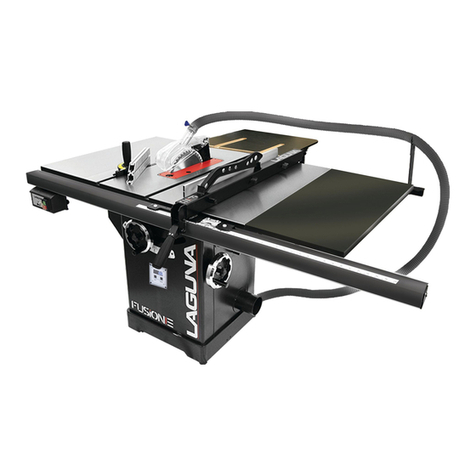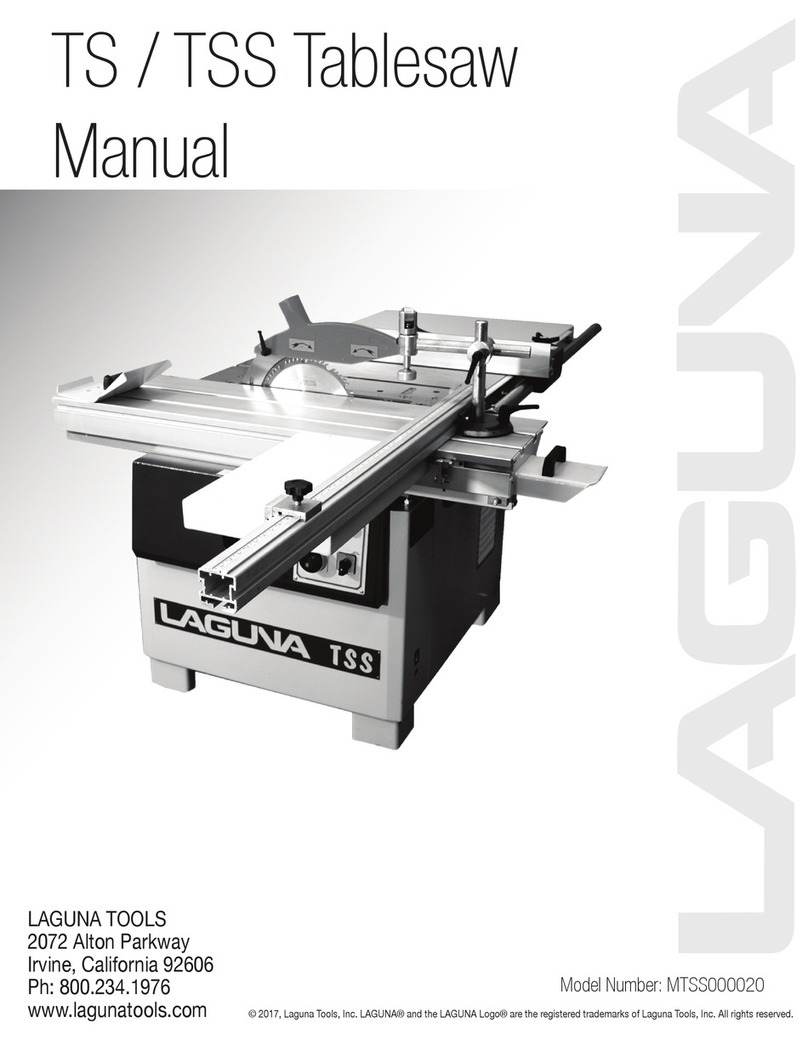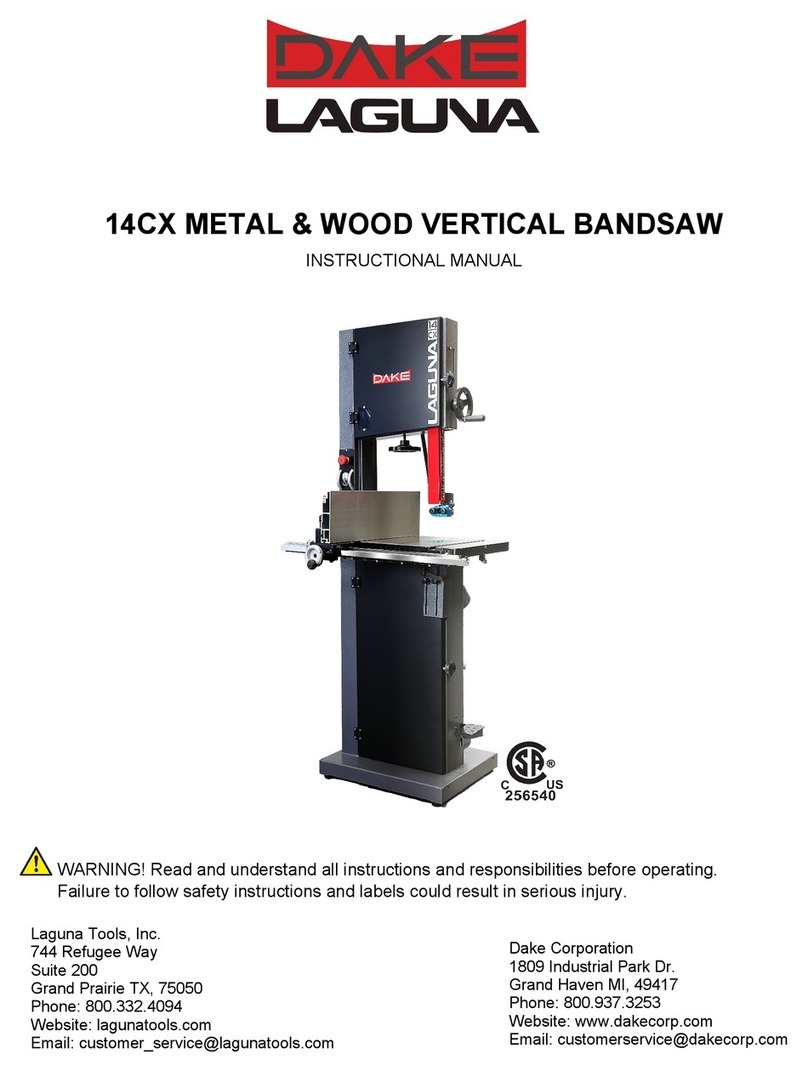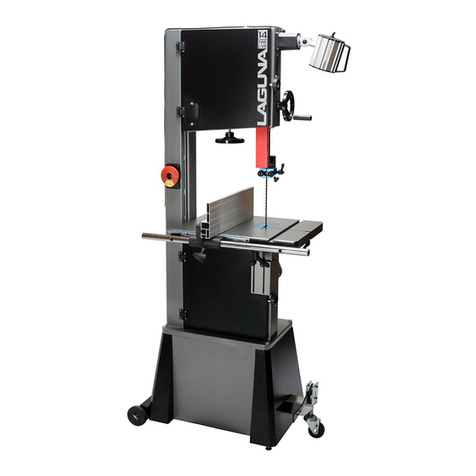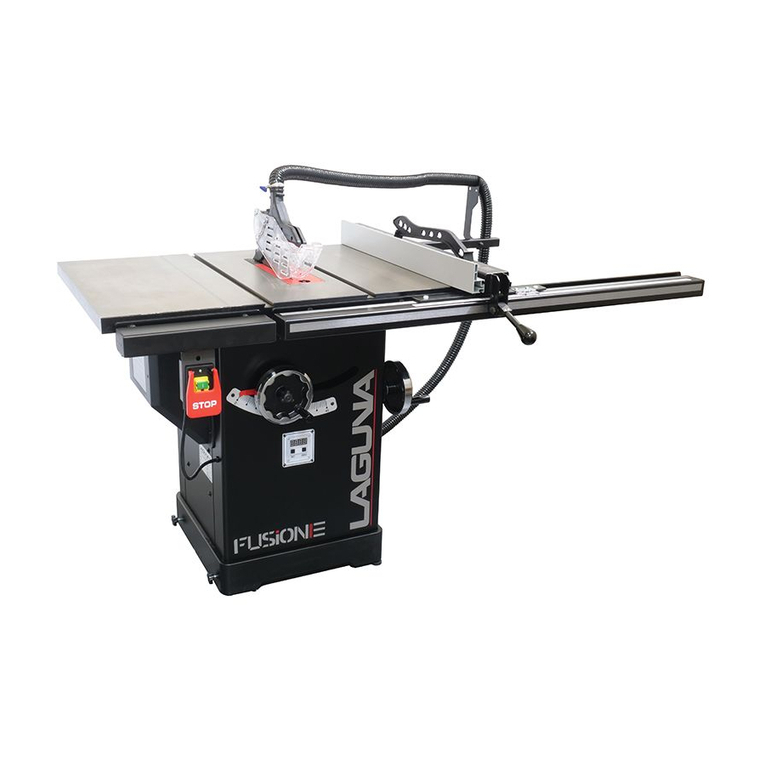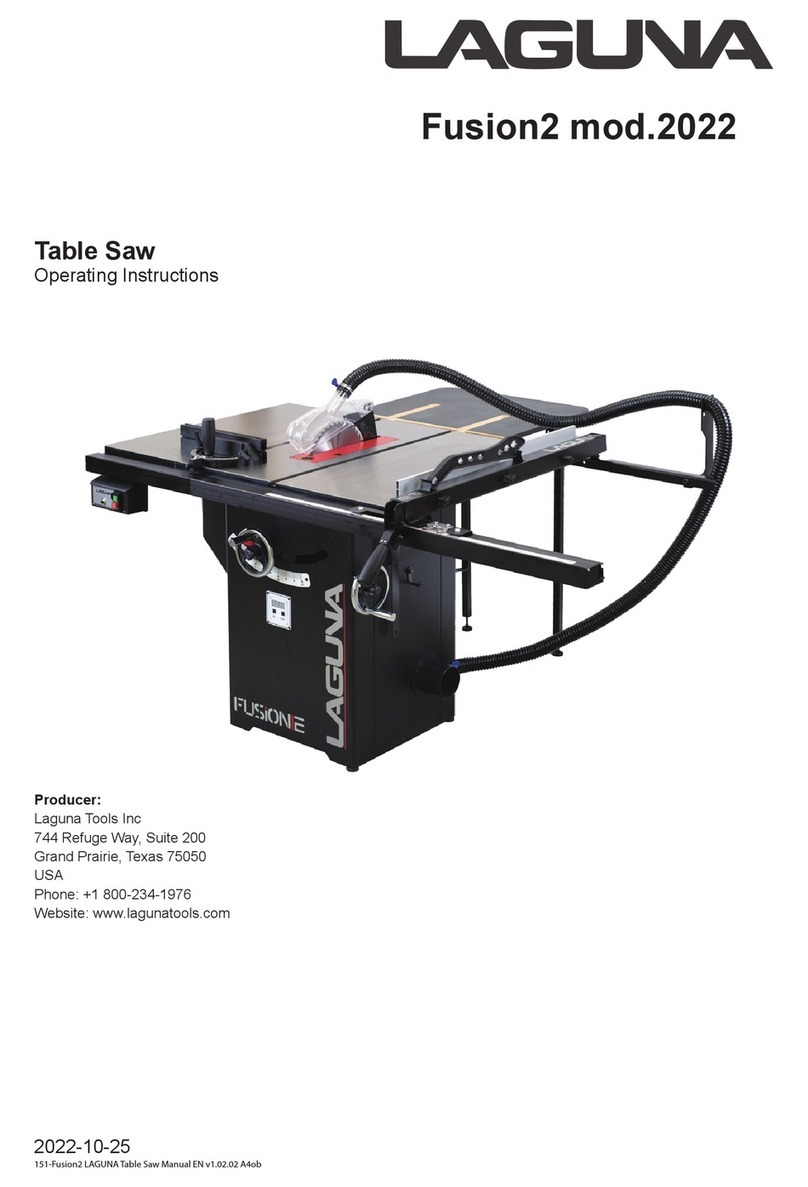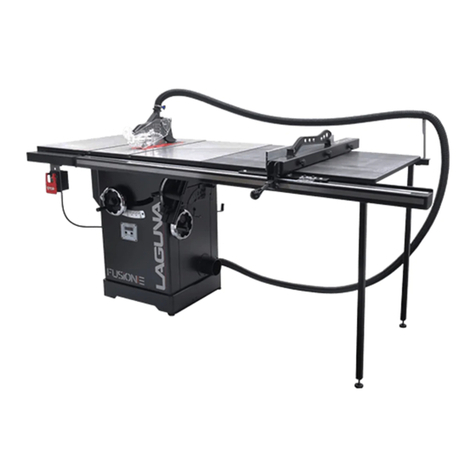
-5-www.igmtools.com
19. Guards
When running, the blade can be very dangerous,
and the amount of blade that is exposed must be
kept to a minimum. The machine is supplied with a
number of guards, all of which MUST be installed
and used while the machine is running. There is
a guard that is attached to the lower door and is
adjustable vertically once the door is closed. There
is a guard on the guide vertical adjustment shaft.
20. Blade tilt and tension mechanism
The upper wheel is attached to the tilt and tension
mechanism. This mechanism adjusts the wheel so
that the bandsaw blade can be adjusted for blade
tracking. This is achieved by a screwed handle
at the back of the machine that pushes on the
mechanism and adjusts the axis of the wheel so
that it runs true with the lower wheel. The second
function is to tension the blade, which is achieved
by adjusting the upper ywheel vertically. A handle
is located below upper ywheel and, when rotated,
will move the wheel up or down. The machine
has a quick-acting blade release mechanism that
is located at the back of the machine and will
remove the tension from the blade to speed the
removal and tting of blades. The mechanism has
a spring, which helps to keep the tension constant
as the blade expands and contracts with the heat
generated by the cutting action.
21. Electrical connection
The bandsaw is provided with a cable.
22. Identication
There is a plate at the back of the
machine listing all the
manufacturing data.
3.2 Specication
Motor voltage 400V, 2,2 kW, 50Hz, 3 Ph
Breaker 3 x 16 A,
tripping characteristic C (16/3/C)
Throat 463 mm
Table cast iron 508 mm x 660 mm
Table tilt - 6° + 45°
Mitre slot 9,5 mm x 19 mm
Table height 965 mm
Fly wheel Cast iron
Resaw capacity 406 mm
Minimum blade length 3651 mm
Maximum blade length 31,75 mm
Minimum blade width 3 mm
Guides Ceramic
Height 1 975 mm
Machine dimensions (W x D) 919 x 759 mm
Base footprint 688 x 500 mm
Machine dimensions with mobility kit (W x D)
1093 x 797 mm
Base footprint with mobility kit
949 x 618 mm
Weight gross 200 kg
Weight net 186 kg
Package size W x D x H
2070 x 860 x 615 mm
Mobility kit Optional
Industrial work-light Optional
Fence Face Dimensions 18,5 x 57,5 cm
3.3 Noise emission
Equivalent A-weighted Sound pressure level
according to EN ISO 3746: 73.56 dB(A)
Uncertainty, K in decibels: 4.0 dB (A) according to
EN ISO 4871 The gure quoted is emission levels
and are not necessarily safe working levels. Whilst
there is a correlation between the emission and
exposure levels, this cannot be used reliably to
determine whether or not further precautions are
required. Factors that inuence the actual level of
exposure of the workforce include characteristics
of the work room, the other sources of noise, etc.
Like the number of machines and other adjacent
processes.
4. General safety
Warning: Read all safety considerations. Failure
to follow this set of guidelines can result in
unwarranted damage to the machine and serious
injury to the operator and bystanders. Save all
warnings and instructions for future reference.
4.1 Safety instructions
• Keep guards in place and in working order.
• Remove adjusting keys and wrenches. Form
habit of checking to see that keys and adjusting
wrenches are removed from tool before turning it
on.
• Keep work area clean. Cluttered areas and
benches invite accidents.
• Don’t use in dangerous environment. Don’t use
power tools in damp or wet locations, or expose
them to rain. Keep work area well lighted.
• Keep children away. Ali visitors should be kept
safe distance from work area.
• Make workshop kid proof with padlocks, master
switches or by removing starter keys.
• Don’t force tool. It will do the job better and safer
at the rate for which it was designed.
• Use right tool. Don ‘t farce tool or attachment to
do a job for which it was not designed.
• Use proper extension cord. Make sure your
extension cord is in good condition. When using an
extension cord, be sure to use one heavy enough
to carry the current your product will draw. An
undersized cord will cause a drop in line voltage,
resulting in loss of power and overheating. Table a
shows the correct size to use depending on cord
length and nameplate ampere rating. If in doubt,
use the next heavier gage. The smaller the gage
number, the heavier the cord.
• Wear proper apparel. Do not wear loose clothing,
gloves, neckties, rings, bracelets or other jewelry
that may get caught in moving parts. Nonslip
footwear is recommended. Wear protective hair
covering to contain long hair.
• Always use safety glasses. Also use face or
dust mask if cutting operation is dusty. Everyday
eyeglasses only have impact-resistant lenses; they
are not safety glasses.
• Secure work. Use clamps or a vise to hold work
when practical. Lt’s safer than using your hand,
and it frees both hands to operate tool.
• Don’t overreach. Keep proper footing and
balance at all times.
• Maintain tools with care. Keep tools sharp
and clean for best and safest performance.
Follow instructions for lubricating and changing
accessories.
• Disconnect tools before servicing, when changing
accessories such as blades, bits and cutters.
• Reduce the risk of unintentional starting.
Make sure switch is in o position before plugging
in.
• Use recommended accessories. Consult the
owner’s manual for recommended accessories.
The use of improper accessories may cause risk of
injury to persons.
• Never stand on tool serious injury could
occur if the tool is tipped or if the cutting tool is
unintentionally contacted.
• Check damaged parts. Before further use of
the tool, a guard or other part that is damaged
should be carefully checked to determine that it will
operate properly and perform its intended function
- check for alignment of moving parts, binding of
moving parts, breakage of parts, mounting and
any other conditions that may aect its operation.
A guard or other part that is damaged should be
properly repaired or replaced.
• Direction of feed. Feed work into a blade or cutter
against the direction of rotation of the blade or
cutter only.
• Never leave tool running unattended turn power
o. Don’t leave tool until it comes to a complete
stop.
Location of warning signs
Because the direction of the blade is always
downward toward the table, there is little danger
(except for special cuts) that the wood will be
thrown back at the operator, which is called a
kickback. There is always danger of kickback when
a circular saw is being used. For safety reasons
many woodworkers prefer the bandsaw especially
when cutting small pieces. The unique feature of
the bandsaw is that the work piece can be rotated
around the blade creating a curve. It is the tool
most often used when curves have to be cut in
wood. Because the bandsaw blade is fairly thin, it
can cut thick stock with a minimum of horsepower.
For this reason the bandsaw is often used when
valuable pieces of wood are made into a thin piece
of veneer.
5. Unpacking your machine
5.1 Transport and unpacking
It is probable that your machine will be delivered
by a third party. Before you unpack your new
machine, you will need to rst inspect the packing,
invoice and shipping documents supplied by the
driver.
Ensure that there is no visible damage to the
packing or the machine. You need to do this prior
to the driver leaving. All damage must be noted on
the delivery documents and signed by you and the
delivery driver. You must then contact the seller
within 24 hours.
5.2 Unpacking
To unpack your machine, you will need tin snips,
knife and a wrench.
Note: The machine is heavy, and if you have
any doubt about the described procedure, seek
professional assistance. Do not attempt any
procedure that you feel is unsafe or that you do not
have the physical capability of achieving.
Using the tin snips, cut the banding that is securing
the machine to the pallet (if tted).
WARNING: EXTREME CAUTION MUST BE
USED BECAUSE THE BANDING WILL SPRING
AND COULD CAUSE INJURY.
Your bandsaw will be shipped in custom packaging
consisting of a heavy-duty cardboard box and
Styrofoam internal packaging.
1. Open the cardboard box and remove the loose
parts and top Styrofoam.
2. Lift the bandsaw out of the packaging. You
will need two or more people, as the bandsaw is
heavy.
3. Lift the bottom Styrofoam out and remove the
parts that are packaged under the
bandsaw and packaging.
